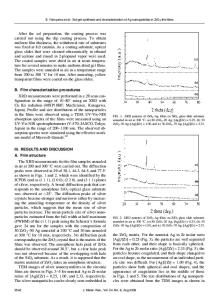Detection of thiourea with ternary Ag 2 O/TiO 2 /ZrO 2 nanoparticles by electrochemical approach
- PDF / 3,014,461 Bytes
- 12 Pages / 595.276 x 790.866 pts Page_size
- 63 Downloads / 357 Views
Detection of thiourea with ternary Ag2O/TiO2/ZrO2 nanoparticles by electrochemical approach Mohammed M. Rahman1,2 · M. M. Alam3 · Abdullah M. Asiri1,2 Received: 5 May 2020 / Accepted: 25 July 2020 © Springer Science+Business Media, LLC, part of Springer Nature 2020
Abstract In this approach, the ternary co-doped Ag2O/TiO2/ZrO2 nanoparticles (NPs) were synthesized by hydrothermal method in alkaline medium at low temperature. The powder X-ray diffraction (XRD), X-ray photoelectron spectroscopy (XPS), field emission scanning electron microscopy (FESEM) equipped with energy-dispersive X-ray spectroscopy (EDS) were applied for detail characterization such as phase crystallinity, crystal size, binding energy, oxidation state of components, elemental compositions, structural as well as morphological analyses of synthesized NPs. A linear relation of current versus concentration for the purpose of thiourea (TU) detection was established, which is known as calibration curve. From the slope of calibration curve by considering the active surface area of fabricated GCE (0.0316 cm2), the sensitivity of TU sensor was calculated as 56.3892 µA µM−1 cm−2. The linear segment on calibration curve analogues with the regression co-efficient R2 = 0.9996 is denoted as linear dynamic range (LDR; 0.1 nM–0.01 mM) as well as the lower limit of TU (91.70 ± 4.59 pM) detection is calculated in this approach. The sensor parameters such as reproducibility, response time and long-time stability are found as acceptable and good results besides the other sensor performances. The proposed TU sensor is found as reliable in detection of real biological samples. This is a well-known electrochemical method to prepare an efficient chemical sensor probe with doped nanostructure materials for the safety of environmental and healthcare fields at broad scales.
1 Introduction In the aspect of science and technology, the thiourea is an important organic compound consist of sulfur, hydrogen, nitrogen and carbon and used to produce agrochemicals, veterinary, human medicines, cleaning agent, electrodeposition of metals, rubber vulcanization and as additive in food industries [1–3]. To protect the horticulture browning, it is a suitable reagent [4]. As useful agrochemical, TU is a potential medicine to inhabit the early raping of fruits, * Mohammed M. Rahman [email protected] * M. M. Alam alam‑[email protected] 1
Chemistry Department, Faculty of Science, King Abdulaziz University, P.O. Box 80203, Jeddah 21589, Saudi Arabia
2
Center of Excellence for Advanced Materials Research (CEAMR), King Abdulaziz University, P.O. Box 80203, Jeddah 21589, Saudi Arabia
3
Department of Chemical Engineering and Polymer Science, Shahjalal University of Science and Technology, Sylhet 3100, Bangladesh
tubers dormancy and breaking seeds [5]. Moreover, it is an important preservative for citrus fruits to protect from fungus in cold storage [6]. Based on the data of Unite State Department of Health and Human Services, TU has classified as carcinogenic [7]. Therefo
Data Loading...










